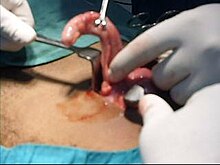Appendix vermiformis

The vermiform appendix , German appendix (colloquially also falsely "appendicitis" called) is an appendage of the cecum ( the cecum ) in some mammals. In humans, it is usually about ten centimeters long. Like other sections of the digestive tract , the appendix has a lumen and the typical structure of the intestinal wall, in which, however, numerous lymph follicles can be found. This is an indication of tasks in the immune defense , which is why he also called intestinal tonsil is called and gut-associated immune system is counted (GALT).
Occurrence
An appendix have all the great apes , most it is in humans and gorillas developed. When Gibbons , tree Stach learning , porcupines , anomalure , beavers , wombats , pocket mice , rabbits and pikas also comes a Wurmfortsatz before, during Galagos , Loris , ordinary Makis , koala lemurs , Cercopithecidae , Capuchin-like , marmosets , climbing marsupials , ring marsupials , long-tailed mice , gerbils and sand graves is its occurrence variable. In platypus , mouse opossums and ant urchins, there are worm-like structures. In contrast, most other mammals, amphibians and reptiles do not have an appendix. But even in mammals without an appendix, the blind end of the appendix is rich in lymphatic tissue.
anatomy
The vermiform appendix is usually found in the right lower abdomen, lies intraperitoneally and has its own mesentery , the mesoappendix (formerly also called mesenteriolum in specialist circles ). Its position in the abdominal cavity is quite variable. The appendix is about 10 cm long, but can be significantly longer in individual cases, and has an outer diameter of 7 to 8 mm and an inner ( lumen ) of 1 to 3 mm. In around 65% of people, the appendix is located behind the cecum ( retrocaecal or retrocoecal ); in about 31% of the cases it has a descending position. Other variants are possible (especially if a Coecum mobile is present ), e.g. B. in the upper abdomen with elevated caecum or the left-sided position in the case of the situs inversus . Since the departure of the appendix from the caecum is relatively constant, it can be easily localized with the help of the McBurney or Lanz point .
The appendix is arterially supplied by the appendicular artery from the ileocolic artery.
function
If it was originally believed that the appendix was merely a rudiment that has meanwhile become functionless, i.e. a feature that has lost its function in the course of evolution, recent research has given other clues. According to a research group led by William Parker from Duke University in Durham ( North Carolina , USA ), in the case of diarrhea, beneficial intestinal bacteria can survive the intestinal bacterial flora washed out by the diarrhea in favor of the organism. In the niche of the appendix vermiformis, these bacteria, which are embedded in a layer of mucus together with molecules of the immune system, are protected by the cells of the lymphoid tissue surrounding the appendix . After the diarrheal disease subsides, the surviving microbes can very quickly colonize the colon again and thereby displace harmful germs.
Today this useful function is of particular importance to humans, primarily in countries with poor hygienic conditions. Under good hygienic conditions, the appendix has become superfluous according to previous knowledge, which is why its removal after an inflammation usually does not have any negative effects on the people affected in developed countries.
Diseases
The appendix is prone to inflammation , which leads to the clinical picture of appendicitis ( inflammation of the appendix ). The disease usually occurs in childhood. At the McBurney point , appendicitis often causes tenderness or tension in the immune system. The removal of the appendix is called an appendectomy . Appendix carcinoma is also rare .
literature
- N. Papastavrou: appendix . In: Surgery historically: beginning - development - differentiation. Edited by FX Sailer and FW Gierhake, Dustri-Verlag, Deisenhofen near Munich 1973, ISBN 3-87185-021-7 , pp. 132-138
Web links
Individual evidence
- ↑ Federative Committee on Anatomical Terminology (FCAT): Terminologia Anatomica. Thieme, Stuttgart 1998.
- ↑ GBD Scott: The primate caecum and appendix vermiformis . In: Journal of Anatomy , Volume 131, Issue 3, 1980, pp. 549-563.
- ↑ a b H. F. Smith et al .: Comparative anatomy and phylogenetic distribution of the mammalian cecal appendix. In: J. Evol. Biol. Volume 22, Issue 10, 2009, pp. 1984-1999 ( full text ).
- ↑ Petra Köpf-Maier: Wolf Heidegger's Atlas of Human Anatomy. 6th edition. Verlag Karger, Basel 2004, ISBN 3-8055-7663-3 (Volume 2), p. 196.
- ↑ Ernst Kern : Seeing - Thinking - Acting of a surgeon in the 20th century. ecomed, Landsberg am Lech 2000, ISBN 3-609-20149-5 , p. 202 f.
- ^ R. Randal Bollinger, Andrew S. Barbas et al. a .: Biofilms in the large bowel suggest an apparent function of the human vermiform appendix. In: Journal of Theoretical Biology. 249, 2007, p. 826, doi: 10.1016 / j.jtbi.2007.08.032 .
- ↑ Charité: Minimally Invasive Surgery Appendectomy ( Memento from February 22, 2014 in the Internet Archive )

